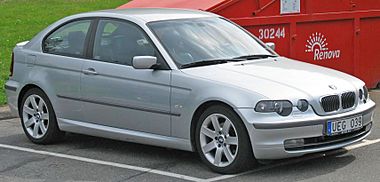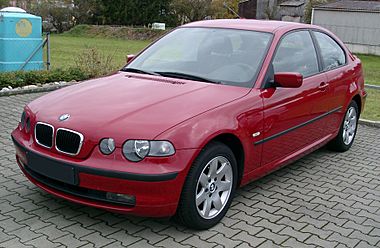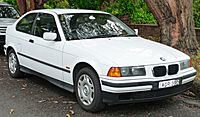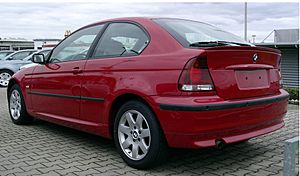BMW 3 Series Compact facts for kids
Quick facts for kids BMW 3 Series Compact |
|
|---|---|
 |
|
| Overview | |
| Manufacturer | BMW |
| Production | 1993–2004 |
| Body and chassis | |
| Class | Small executive car (C) |
| Body style | 3-door hatchback |
| Layout | Front engine, rear-wheel drive |
| Chronology | |
| Predecessor | BMW 2002 Touring |
| Successor | BMW 1 Series (E87) |
The BMW 3 Series Compact was a special car made by BMW from 1993 to 2004. It was a smaller, 3-door hatchback version of the popular BMW 3 Series.
This car was first built on the E36 platform. Later, in 2001, it switched to the newer E46 platform.
When it first came out, it had four-cylinder petrol engines. Over time, BMW added more engine choices. These included engines that ran on compressed natural gas, diesel engines, and even more powerful six-cylinder petrol engines.
What made the 3 Series Compact different from many other hatchbacks was its rear-wheel drive. Most hatchbacks use front-wheel drive.
In 2004, the 3 Series Compact was replaced by the 1 Series.
Contents
First Generation (E36; 1994-2000)
| BMW 3 Series Compact | |
|---|---|
| Overview | |
| Production | 1993–2000 |
| Body and chassis | |
| Platform | BMW 3 Series (E36) |
| Powertrain | |
| Engine |
|
| Dimensions | |
| Wheelbase | 2,700 mm (106.3 in) |
| Length | 4,210 mm (165.7 in) |
| Width | 1,698 mm (66.9 in) |
| Height | 1,393 mm (54.8 in) |
| Weight | 1,175 kg (2,590 lb)−1,290 kg (2,844 lb) |
The first BMW 3 Series Compact, known as the E36/5, came out in 1994. This was BMW's first hatchback since the 2002 Touring model stopped being made in 1974.
The front part of the E36/5, from the bumper to the front window frame (called the A-pillar), looked exactly like the E36 saloon (sedan) car. However, everything behind the A-pillar was unique to the Compact.
Even though the E36/5 was about 200 millimetres (7.9 in) shorter than other E36 3 Series cars, its wheelbase (the distance between the front and rear wheels) was the same.
From mid-1995, you could get a special version with a large, folding canvas roof. This was called the California Top Edition or Open Air Edition.
In September 1996, the 3 Series Compact got a small update, also known as a facelift. This included new tail-lights, grille, bumpers, and mirrors.
Suspension and Interior
The front suspension of the E36 Compact used the same MacPherson strut design as other E36 models. However, the rear suspension was different. It used an older design from the previous generation E30 models. This older design was more compact and cheaper to make. Some people thought this made the E36/5's handling a bit tricky, especially around corners.
The inside of the car was mostly like the E36 saloon models. But it had folding rear seats and a dashboard that shared some parts with the older E30 3 Series.
Engine Options (E36)
The E36 Compact came with different engines. Here are some of the main ones:
| Model | Years | Engine Type | Power | Top speed |
|---|---|---|---|---|
| 316i | 1994–1999 | 1.6 L I4 | 75 kW (102 PS; 101 hp) | 188 km/h (117 mph) |
| 316i | 1999–2000 | 1.9 L I4 | 77 kW (105 PS; 103 hp) | 190 km/h (118 mph) |
| 316g* | 1995–2000 | 1.6 L I4 | 60 kW (82 PS) | - |
| 318ti | 1994–1998 | 1.8 L or 1.9 L I4 | 103 kW (140 PS; 138 hp) | 209 km/h (130 mph) |
| 323ti | 1997–2001 | 2.5 L inline-6 | 125 kW (170 PS; 168 hp) | 230 km/h (143 mph) |
| 318tds (diesel) |
1995–2001 | 1.7 L turbo I4 | 66 kW (90 PS; 89 hp) | 175 km/h (109 mph) |
* The 316g could run on either gasoline or compressed natural gas (CNG).
Special M3 Compact
In 1996, BMW M (the high-performance division of BMW) built a special M3 Compact. This car was made to celebrate the 50th birthday of a German car magazine. It had all the powerful parts of the standard E36 M3, but in the smaller Compact body. It even had cool features like special sports seats and a unique steering wheel.
Sales in North America
In North America (like the USA and Canada), only the 318ti model was sold. It first had a 1.8-litre engine, which was later updated to a 1.9-litre engine.
The E36 Compact was very popular in Europe. However, it didn't sell very well in North America. Because of this, BMW stopped selling the Compact there in 1999. This also meant that the next generation of the Compact (the E46) was not sold in North America.
Second Generation (E46/5; 2000-2004)
| Second generation (E46/5) | |
|---|---|
 |
|
| Overview | |
| Production | 2000–2004 |
| Body and chassis | |
| Platform | BMW 3 Series (E46) |
| Powertrain | |
| Engine |
|
| Dimensions | |
| Wheelbase | 2,725 mm (107.3 in) |
| Length | 4,260 mm (167.7 in) |
| Width | 1,751 mm (68.9 in) |
| Height | 1,408 mm (55.4 in) |
| Weight | 1,300 kg (2,866 lb)−1,405 kg (3,097 lb) |
In 2000, the 3 Series Compact got a complete redesign. It was now based on the newer E46 platform. This updated model was known as the E46/5.
The wheelbase of the E46 Compact was 25 mm (1.0 in) longer than the previous model. The total length of the car also grew by 52 mm (2.0 in).
The outside of the E46/5 looked quite different from other E46 3 Series cars. It had unique headlights and tail-lights that made it stand out. Inside, many parts were shared with other E46 models. However, the steering felt quicker and more responsive.
As mentioned before, the E46/5 was not sold in North America. This was because the previous model hadn't sold well there.
Engine Options (E46)
The E46 Compact also offered a range of engines, including both petrol and diesel options.
Petrol Engines
| Model | Years | Engine Type | Power |
|---|---|---|---|
| 316ti | 2002–2004 | 1.6 L I4 | 85 kW (116 PS; 114 hp) |
| 316ti | 2001–2004 | 1.8 L I4 | 85 kW (116 PS; 114 hp) |
| 318ti | 2001–2004 | 2.0 L I4 | 105 kilowatts (143 PS; 141 hp) |
| 325ti | 2001–2004 | 2.5 L inline-6 | 141 kilowatts (192 PS; 189 hp) |
Diesel Engines
| Model | Years | Engine Type | Power |
|---|---|---|---|
| 318td | 2003–2004 | 2.0 L turbo I4 | 85 kW (116 PS; 114 hp) |
| 320td | 2001–2004 | 2.0 L turbo I4 | 110 kW (150 PS; 150 hp) |
See also
 In Spanish: BMW Serie 3 Compact para niños
In Spanish: BMW Serie 3 Compact para niños




